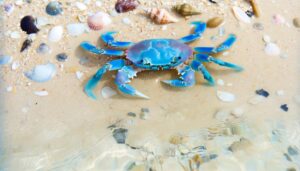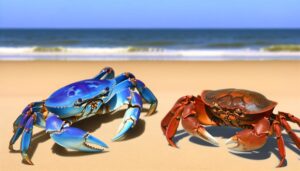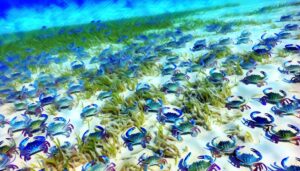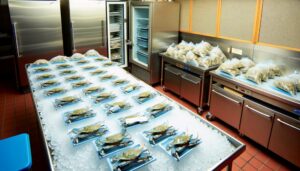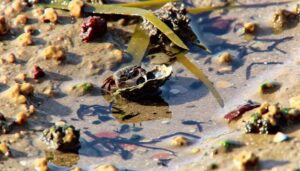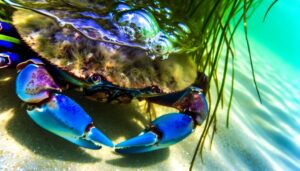How Do Fiddler Crabs’ Eyes Grow Back Step by Step?
Fiddler crabs (genus Uca) are opportunistic omnivores that primarily feed on detritus, algae, and small invertebrates. They exhibit no direct parental care, releasing their larvae into coastal or brackish waters where the larvae develop independently.
While there is evidence of cannibalism under conditions of resource scarcity and high population density, it is not a dominant behavior. The crabs rely on various survival strategies, including burrow construction and larval release during high tides, to secure offspring survival.
Understanding these ecological practices provides further insights into their complex life cycle and interactions within their habitat.
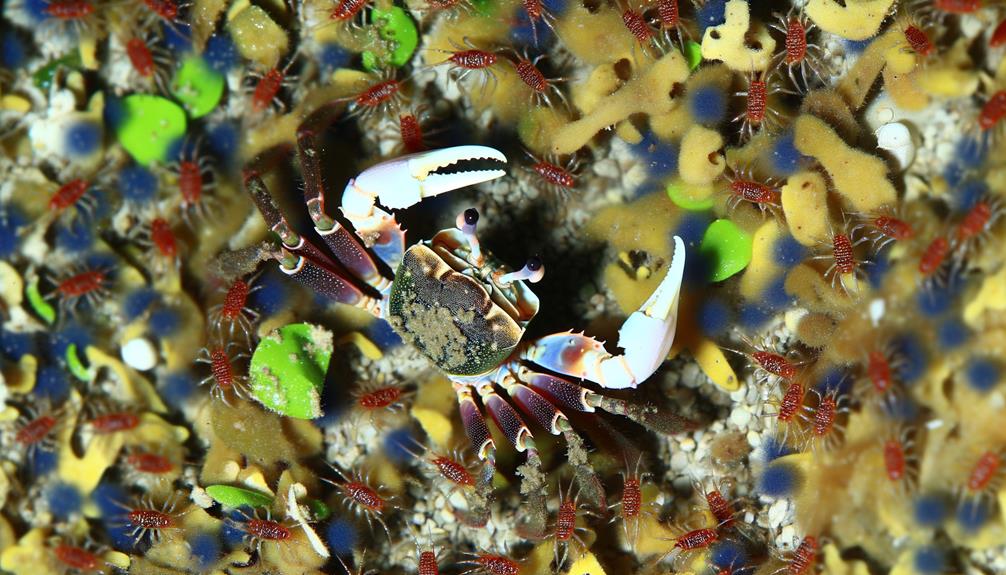
Key Takeaways
- Fiddler crabs typically release larvae into the water, reducing the likelihood of direct cannibalism.
- There is no direct parental care for the offspring after the release of larvae.
- Cannibalism may occur under resource scarcity or high population density conditions.
- Larval dispersal during high tides helps avoid cannibalism by adult crabs.
- Cannibalism can be a survival strategy in response to predation pressure or limited food availability.
Fiddler Crab Basics
Fiddler crabs, belonging to the genus Uca, are small, semi-terrestrial crabs known for their distinctive sexually dimorphic claws and their unique behaviors.
Males possess an oversized claw, used for communication and combat, while females have two smaller, symmetrical claws.
These crabs exhibit a range of intriguing behaviors including complex burrowing activities and intricate mating rituals.
Anatomically, they display a high degree of specialization; their asymmetrical claws serve different functions, such as attracting mates and deterring rivals. Additionally, they possess specialized mouthparts for filter-feeding and sediment processing.
Their life cycle includes a larval stage, where larvae are released into the water column before undergoing metamorphosis into juvenile crabs.
Understanding these basics is essential before delving into their reproductive behaviors and potential cannibalism.
Natural Habitat
Fiddler crabs mainly inhabit coastal and brackish waters, showcasing a preference for mangroves and mudflats. These environments provide the ideal mixture of sandy or muddy substrates and tidal influences necessary for their burrowing and feeding behaviors.
The specific ecological conditions of these habitats play a critical role in the life cycle and survival strategies of fiddler crabs, including their reproductive practices.
Coastal and Brackish Waters
Coastal and brackish waters serve as the primary natural habitats for crabs, providing a unique environment characterized by fluctuating salinity levels and abundant organic material necessary for their survival and reproduction.
These waters, where freshwater and seawater mix, create dynamic ecosystems supporting diverse marine life.
For fiddler crabs, these habitats offer plentiful food sources, including detritus and microorganisms, which are essential for their sustenance.
The variable salinity conditions also facilitate their physiological adaptability, enabling them to thrive in different aquatic conditions.
Additionally, the sediment composition in these regions is ideal for burrowing, which is important for their protection against predators and environmental stressors.
Therefore, coastal and brackish waters play a critical role in the life cycle and ecological success of fiddler crabs.
Mangroves and Mudflats
In addition to coastal and brackish waters, mangroves and mudflats also serve as essential habitats for fiddler crabs, offering a rich interplay of nutrient-dense sediments and complex root systems that support their burrowing behavior and ecological activities. These environments provide ample hiding spots and foraging opportunities, essential for their survival and reproduction.
The intricate root networks of mangroves stabilize sediment, creating microhabitats that protect juvenile crabs from predators. Mudflats, characterized by their high organic matter, offer an abundant food source, including detritus and microorganisms. This habitat complexity allows fiddler crabs to thrive, facilitating their role in aerating soil and recycling nutrients.
Understanding these habitats is important for conservation efforts aimed at maintaining ecological balance.
Diet Overview
The diet of fiddler crabs primarily consists of detritus, algae, and small invertebrates, reflecting their role as opportunistic omnivores within their ecosystem. These feeding habits allow them to efficiently recycle nutrients and maintain the ecological balance in their habitats. Fiddler crabs utilize their specialized claws to sift through sediment, extracting edible particles. This diet is essential for their growth, reproduction, and survival. Below is an overview of their common food sources:
| Food Type | Examples |
|---|---|
| Detritus | Decomposed plant matter |
| Algae | Microalgae and seaweed |
| Small Invertebrates | Worms, larvae |
| Organic Particles | Bacterial biofilms |
| Plant Material | Mangrove leaves |
Understanding their diet helps elucidate their ecological role and behavior.
Reproduction Cycle
Fiddler crabs display a complex reproduction cycle that involves intricate mating rituals, precise timing correlated with tidal patterns, and specialized larval development stages.
Males attract females by waving their enlarged claws and constructing burrows, which serve as mating and incubation sites. Mating typically occurs during spring tides, guaranteeing ideal conditions for larval dispersal.
Once fertilized, females incubate their eggs within the burrow until they hatch into zoea larvae. These larvae are then released into the water column, where they undergo several molting stages before reaching maturity.
The synchronization with tidal patterns is essential, as it maximizes the chances of larval survival and dispersal. This cyclical process underscores the adaptive strategies employed by fiddler crabs to achieve reproductive success.
Parental Behavior
Parental behavior in fiddler crabs is characterized by a notable lack of direct care for offspring post-hatching, as the larvae are released into the water column to develop independently. Once the female has laid her eggs, she carries them under her abdomen until they hatch.
Upon hatching, the larvae are dispersed into the aquatic environment, where they undergo several planktonic stages before returning to the benthic habitat as juveniles. This reproductive strategy minimizes parental investment in individual offspring but increases the chances of survival by producing a large number of larvae.
Such behavior is typical of many marine organisms, optimizing reproductive success in environments with high predation and variable conditions, thereby enhancing the species' overall fitness and adaptability.
Filial Cannibalism Defined
Filial cannibalism, the act of parents consuming their offspring, is a phenomenon observed in various animal species, including fiddler crabs. This behavior can be influenced by numerous factors, such as environmental stressors, nutritional deficiencies, or the need to control population dynamics.
Analyzing the underlying reasons behind filial cannibalism provides insight into the complex survival strategies employed by these organisms.
Understanding Filial Cannibalism
Defined as the act of parents consuming their own offspring, filial cannibalism is a phenomenon observed in various animal species, including certain types of fish, birds, and invertebrates.
This behavior, while seemingly counterintuitive, can be understood through several biological and ecological frameworks.
Key aspects of filial cannibalism include:
- Frequency: The regularity with which this behavior occurs across different species.
- Selective Consumption: The tendency to consume weaker or less viable offspring.
- Environmental Triggers: Conditions that may prompt such behavior, such as resource scarcity.
- Adaptive Advantages: Potential evolutionary benefits, such as improved parental health and increased survival rates for remaining offspring.
Reasons Behind Behavior
The phenomenon of filial cannibalism can be attributed to several interrelated factors that provide adaptive advantages to the parent and the remaining offspring.
Primarily, resource allocation plays a critical role; consuming a portion of the brood can offer immediate nutritional benefits, thereby enhancing the parent's survival and ability to care for remaining offspring.
Additionally, this behavior can serve as a population control mechanism, reducing competition among siblings and increasing the survival rate of the healthier individuals.
Environmental stressors, such as predation risk or limited food availability, may also drive this behavior, ensuring that only the fittest offspring survive.
Consequently, filial cannibalism represents a complex, multifaceted strategy that balances immediate survival needs with long-term reproductive success.
Evidence of Cannibalism
Multiple scientific studies have documented instances of cannibalistic behavior among fiddler crabs, revealing a complex interplay of ecological and evolutionary factors. These studies have provided empirical evidence highlighting various conditions under which such behavior occurs:
- Resource Scarcity: Limited availability of food resources can drive fiddler crabs to consume their young.
- Population Density: High population density increases competition, leading to higher rates of cannibalism.
- Parental Investment: Some parents may consume weaker offspring to improve the survival chances of the stronger ones.
- Predation Pressure: Under threat from predators, adult crabs might eat their young to reduce detection.
Survival Strategies
A myriad of survival strategies have evolved among fiddler crabs to mitigate the risks posed by both environmental pressures and intra-species threats. These strategies encompass behavioral adaptations, habitat selection, and reproductive tactics to guarantee offspring survival. For example, female fiddler crabs often release larvae during high tides to minimize predation. Additionally, burrow construction offers refuge from predators and environmental extremes. The following table highlights key survival strategies and their emotional implications:
| Strategy | Description | Emotional Impact |
|---|---|---|
| Burrow Construction | Provides protection from predators and harsh weather | Sense of security |
| High-Tide Larvae Release | Ensures larvae dispersal, reducing predation risk | Hope for offspring survival |
| Camouflage | Blends with surroundings to avoid detection | Instinctual fear of predation |
| Cannibalism Avoidance | Reduces intra-species threats to young | Familial tension |
These strategies collectively enhance the survival prospects of fiddler crabs, demonstrating their evolutionary resilience.
Ecological Impact
Understanding the ecological impact of fiddler crabs requires a thorough examination of their role in coastal ecosystems, especially concerning sediment turnover, nutrient cycling, and their interactions with other species. Fiddler crabs are pivotal in maintaining the health and functionality of these habitats. Their burrowing activities facilitate:
- Sediment turnover: Enhancing soil aeration and mitigating erosion.
- Nutrient cycling: Through the decomposition of organic matter, enriching soil fertility.
- Habitat engineering: Creating microhabitats for other organisms, such as worms and small fish.
- Food web interactions: Serving as prey for birds and larger crustaceans.
These activities contribute to the robustness of coastal ecosystems, underscoring the importance of preserving fiddler crab populations for ecological balance and biodiversity conservation.
Comparative Analysis
In conducting a comparative analysis of fiddler crabs' dietary behaviors, it is essential to examine their feeding habits in relation to other crustaceans and assess any instances of cannibalism under various environmental conditions. Studies indicate that while fiddler crabs primarily consume detritus and algae, they may occasionally exhibit cannibalistic behaviors, especially under stress or high competition. This tendency is also observed in other crustaceans such as shrimp and lobsters.
| Crustacean Type | Cannibalistic Behavior |
|---|---|
| Fiddler Crabs | Occasional |
| Shrimp | Common under stress |
| Lobsters | Frequent in captivity |
Understanding these behaviors across species provides insights into the ecological dynamics and evolutionary strategies influencing survival and reproduction within crustacean populations.
Conclusion
To sum up, while fiddler crabs exhibit a broad range of behaviors, instances of cannibalism, particularly involving their offspring, appear to be relatively rare.
Like a gardener pruning to promote healthier growth, these behaviors may serve ecological functions, such as population control and resource optimization.
Understanding these dynamics provides insight into the complex survival strategies within their natural habitats, highlighting the intricate balance of ecological interactions that sustain their populations.
Further research is necessary to fully comprehend these phenomena.

